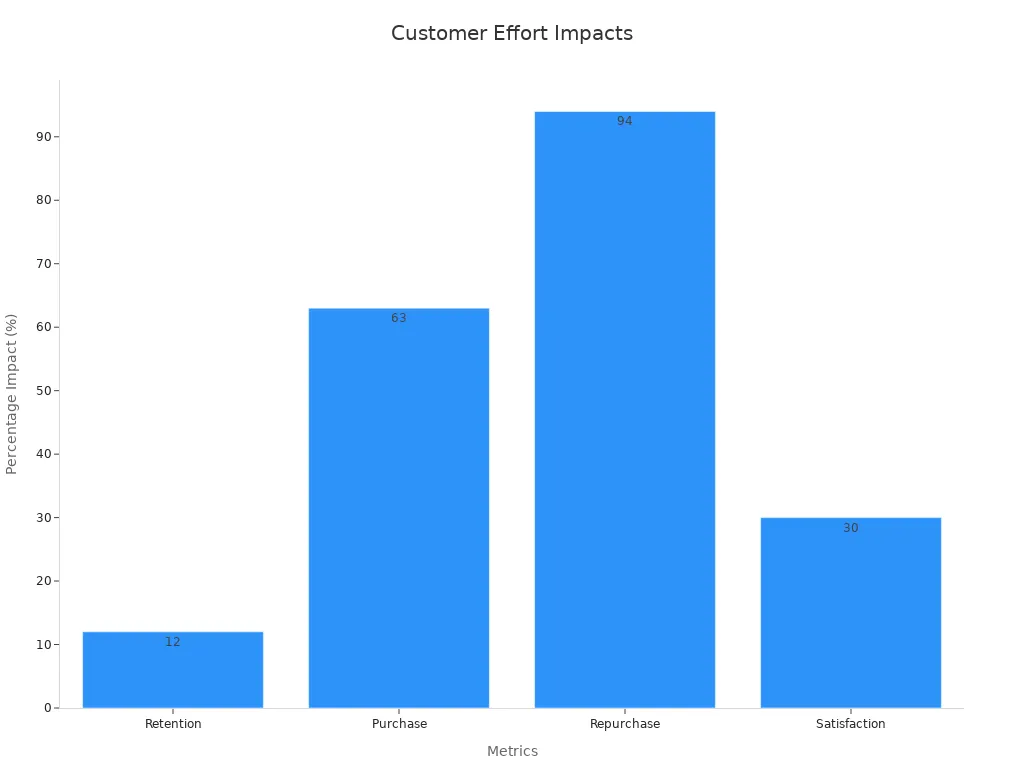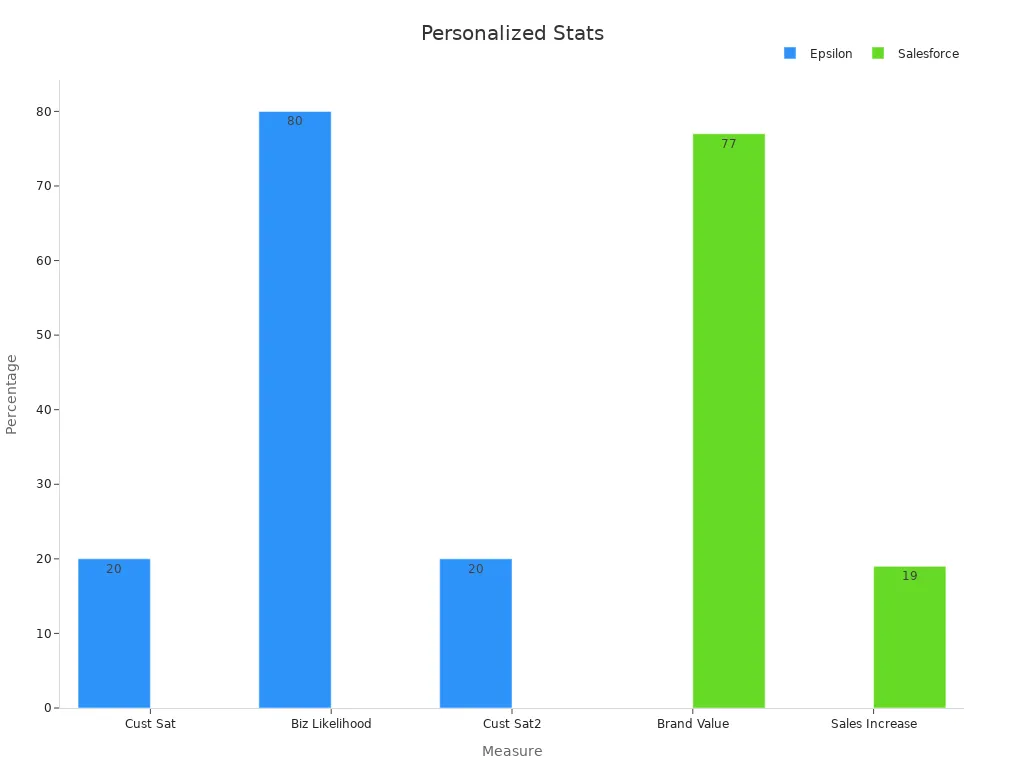Using Customer Effort Score to Build Long-Term Loyalty

Creating loyal customers starts with making their experience effortless. The Customer Effort Score (CES) helps you measure how easy it is for your customers to interact with your business. When interactions are simple, customers feel satisfied and return more often. Research shows that customers who face high-effort interactions are more likely to become disloyal, while only 9% of those with low-effort experiences do the same. By focusing on reducing effort, businesses often see a 20% drop in service costs and stronger loyalty metrics. Tools like Sobot can help you design a clear customer effort score question to identify pain points and improve satisfaction. CES is also 1.8x more effective than traditional metrics like CSAT or NPS in predicting customer behavior. Simplifying your processes not only benefits your customers but also strengthens your relationship with them.
What is Customer Effort Score (CES)?
Definition and purpose of CES
The Customer Effort Score (CES) measures how easy it is for your customers to interact with your business. It focuses on the effort required to resolve issues, complete purchases, or access services. Unlike traditional metrics like Customer Satisfaction (CSAT) or Net Promoter Score (NPS), CES directly evaluates the simplicity of your processes. Research shows CES is 40% more effective in predicting customer loyalty than other satisfaction metrics. This makes it a vital tool for businesses aiming to improve customer experience and foster long-term loyalty. By reducing effort, you can create smoother interactions that encourage repeat business and positive word-of-mouth.
How CES measures customer interactions
CES surveys quantify customer interactions using straightforward scales. These scales help you understand how much effort your customers exert during specific interactions. Common metrics include:
| Scale Type | Description |
|---|---|
| 1–5 Scale | Ranges from Very Easy (1) to Very Difficult (5), providing a broad measure. |
| 1–7 Scale | Offers a more detailed response spectrum for capturing subtle differences. |
| Numbered Scale | Typically 5-point or 7-point scales for measuring agreement or satisfaction. |
| Likert Scale | Measures qualitative feedback on a scale from strongly agree to strongly disagree. |
| Emoticon Ratings | Simple and intuitive metric for quick responses on minor aspects. |
These scales allow you to identify pain points and areas for improvement. For example, if customers consistently rate a process as "Very Difficult," it signals the need for immediate action to simplify that interaction.
Common standards for CES surveys
CES surveys are designed to be simple and actionable. They typically consist of one question: "How easy or difficult was it to get your issue resolved?" Responses are rated on a scale from 0 to 5, where 0 indicates "no effort" and 5 indicates "a lot of effort." This straightforward approach makes CES surveys easy to integrate into your existing feedback systems. You can deploy them through various channels, such as email, chat, or post-service surveys.
Tip: Tools like Sobot can help you design and implement effective CES surveys. With customizable templates and automated workflows, Sobot simplifies the process of collecting and analyzing customer effort score data.
By adhering to these standards, you can ensure your CES surveys provide meaningful insights that drive actionable improvements.
Why Customer Effort Score Matters for Loyalty
The connection between low effort and customer satisfaction
When you make it easy for customers to interact with your business, their satisfaction increases. A low customer effort score directly correlates with higher customer satisfaction. Research shows that reducing customer effort can boost satisfaction metrics by up to 30%. This happens because customers value convenience and efficiency. For example, a simplified checkout process or a quick resolution to a service issue leaves a lasting positive impression.
Low-effort experiences also reduce frustration, which strengthens customer loyalty. Customers who find interactions effortless are more likely to return and recommend your business to others. By focusing on minimizing effort, you create a seamless experience that fosters trust and long-term relationships.
How CES impacts customer retention and repeat business
Customer retention thrives when effort is minimized. Studies reveal that reducing customer effort leads to a 12% increase in retention rates. Customers with low effort are also 63% more likely to make additional purchases. This demonstrates the direct link between effort and purchasing behavior.
High CES scores further enhance loyalty. For instance, customers reporting a CES of 7 or higher show improved retention and satisfaction indicators. These customers are 94% more likely to repurchase from your business. By prioritizing CES, you not only retain existing customers but also encourage repeat business, which drives revenue growth.

Examples of businesses leveraging CES for loyalty
Many businesses have successfully used CES to improve customer loyalty. Blueberry Markets, for example, implemented a feedback system that included CES, CSAT, and NPS. This allowed them to identify areas where customers faced challenges and make necessary improvements. Similarly, Man Crates integrated CES into their feedback process to gain better insights into customer effort. These changes helped both companies enhance customer satisfaction and loyalty.
Tools like Sobot can simplify the process of collecting and analyzing CES data. With features like customizable surveys and automated workflows, Sobot enables you to identify pain points and take actionable steps to improve customer experiences. By leveraging CES effectively, you can build stronger, long-term relationships with your customers.
Designing an Effective Customer Effort Score Survey

Crafting the right Customer Effort Score question
The success of a customer effort score survey depends on asking the right questions. A well-crafted question should be clear, concise, and directly address the ease of interaction. For example, you might ask, "On a scale of 1 to 7, how easy was it to resolve your issue with our product or service?" This type of question focuses on the customer's experience and provides actionable insights.
Other effective questions include:
- How much effort did you personally have to put forth to handle your request?
- Did you encounter any obstacles while trying to accomplish your task?
- How likely are you to recommend our product based on ease of use?
These questions help you identify areas where you can reduce customer effort and improve satisfaction. Tools like Sobot simplify this process by offering customizable templates for crafting effective CES surveys.
Best practices for survey timing and channels
Timing and channel selection play a critical role in gathering accurate feedback. The best time to send a CES survey is immediately after a customer interaction, such as completing a purchase or resolving a support issue. This ensures the experience is fresh in their mind, leading to more accurate responses.
Using multiple channels increases the likelihood of customer participation. You can deliver CES surveys via email, in-app notifications, or directly on your website. For instance:
| Timing Recommendation | Channel Recommendation |
|---|---|
| Send a follow-up email with a survey link | Deliver CES surveys across website, in-app, and email |
| Reach out when the experience is fresh | Use follow-up emails as a best practice |
| Avoid overwhelming customers with too many requests | Use various feedback channels for comprehensive insights |
By following these practices, you can maximize response rates and gather meaningful data.
Ensuring concise and actionable survey design
A concise survey design improves response rates and ensures the feedback is actionable. Customers are more likely to complete surveys that are short and straightforward. For example, asking, "How easy was it to navigate our website?" provides a clear focus and actionable insight.
| Evidence Type | Description |
|---|---|
| Conciseness | The more concise your questions, the more likely you are to have a response that provides actionable insights. |
Sobot's survey tools allow you to design CES surveys that are both concise and impactful. With features like automated workflows and real-time analytics, you can quickly identify trends and take action to enhance the customer experience.
Analyzing and Acting on CES Data
Interpreting CES results to identify trends
Analyzing Customer Effort Score (CES) data helps you uncover patterns in customer interactions. Trends often reveal recurring pain points or areas where customers struggle the most. For example, if many customers rate your checkout process as difficult, it signals an opportunity for improvement.
To identify trends, focus on grouping CES responses by interaction type, channel, or customer segment. This segmentation allows you to pinpoint specific issues. For instance, HubSpot used CES data to identify poor onboarding experiences as a major contributor to customer churn. By addressing this issue, they reduced churn rates significantly.
Visualizing CES data through charts or graphs can also make trends easier to spot. Tools like Sobot provide real-time analytics that simplify this process. With these insights, you can prioritize changes that improve customer experience and satisfaction.
Using CES insights to improve customer experience
CES insights offer actionable feedback that helps you refine your processes. When customers report high effort in specific areas, you can implement targeted solutions to reduce friction. For example, Maersk leveraged CES data to enhance communication and learning processes, resulting in a 40-point increase in Net Promoter Score (NPS) and a 10% rise in shipping volume.
Consider using CES feedback to simplify complex workflows. If customers struggle with navigation on your website, redesign the layout for better usability. Similarly, if they find your return policy unclear, streamline the process and provide clear instructions.
Here’s how companies have used CES insights to improve customer experience:
| Company | Insight from CES | Improvement Achieved |
|---|---|---|
| HubSpot | High churn due to poor onboarding scores | Improved onboarding process, reducing churn |
| Maersk | Continuous learning and communication | 40-point increase in NPS and 10% increase in shipping |
| JACK & JONES | Peak times decreased satisfaction scores | 35% increase in customer satisfaction scores |
By acting on CES feedback, you can create smoother interactions that boost satisfaction and loyalty.
Benchmarking CES scores and tracking progress
Benchmarking CES scores helps you compare your performance against industry standards. It provides a clear picture of where your business stands and highlights areas for improvement. Different industries face unique challenges, but CES benchmarking reveals common solutions that can inspire your strategy.
| Industry | Key Challenges | Solutions Implemented |
|---|---|---|
| Retail and ecommerce | Long checkout times, unclear return policies, difficult navigation | Automated chatbots, streamlined return processes |
| Healthcare | Complex systems for booking, accessing results, billing issues | Intuitive online scheduling, automated reminders |
| Hospitality and travel | Struggling with reservations, unclear policies, long waits | Self-service options, user-friendly booking platforms, AI-powered assistants |
| Finance | Complex loan applications, understanding investments, billing disputes | Improved application clarity, AI chatbots for assistance, seamless communication |
| Government and education | Confusing processes for permits, financial aid | Better self-service tools, clearer communication, faster responses |
Tracking progress over time ensures your CES improvements are effective. Use tools like Sobot to monitor scores and identify trends. Regularly updating your benchmarks keeps your strategies aligned with evolving customer expectations.
Strategies to Enhance Customer Satisfaction Using CES

Identifying and resolving customer pain points
Understanding and addressing customer pain points is essential for creating a frictionless experience. You can identify these pain points by analyzing feedback from CES surveys and mapping the customer journey. For example, if customers frequently report difficulty navigating your website, this signals a need for improvement.
Here are some effective strategies to uncover and resolve pain points:
- Use data analysis tools to detect patterns in customer feedback.
- Implement feedback management systems to monitor recurring issues.
- Document common pain points to prioritize support efforts.
Tip: Automating feedback capture and analysis can streamline this process. AI tools categorize feedback and extract actionable insights, helping you address issues faster.
For instance, a retail company used CES data to identify long checkout times as a major pain point. By introducing self-checkout kiosks, they reduced wait times and improved customer satisfaction. Similarly, Sobot’s feedback management tools allow you to track and analyze pain points, enabling you to take targeted actions that enhance the customer experience.
Simplifying processes to reduce customer effort
Simplifying your processes is key to delivering a low effort experience. Customers value efficiency, and reducing unnecessary steps in their journey can significantly improve satisfaction. For example, a healthcare provider streamlined its appointment booking system by introducing an intuitive online platform. This change reduced booking times by 50% and increased patient satisfaction.
To simplify processes, consider these approaches:
- Map the customer journey to identify roadblocks.
- Optimize workflows by removing redundant steps.
- Leverage technology like chatbots or self-service portals to provide quick solutions.
Quote: "AI has revolutionized the process of understanding customer pain points by automating feedback capture and analysis, allowing businesses to swiftly identify and address core customer issues."
Sobot’s automation tools can help you simplify processes by integrating CES feedback into your workflows. For example, if customers report difficulty finding information, Sobot’s AI-powered chatbots can provide instant answers, reducing effort and improving the overall experience.
Personalizing customer experiences based on CES feedback
Personalization is a powerful way to enhance the customer experience. By tailoring interactions to individual preferences, you can create meaningful connections that drive loyalty. CES feedback provides valuable insights into what your customers need, enabling you to deliver personalized solutions.
Consider these statistics:

| Statistic | Source |
|---|---|
| Companies that provide a personalized experience have a 20% increase in customer satisfaction. | Epsilon |
| 80% of customers are more likely to do business with a company that offers a personalized experience. | Epsilon |
| 77% of customers have chosen, recommended, or paid more for a brand that provides a personalized experience. | Salesforce |
| Companies that provide a personalized experience see a 19% increase in sales. | Salesforce |
To personalize experiences effectively:
- Segment CES feedback by customer demographics or behavior.
- Use this data to tailor recommendations, offers, or communication.
- Provide resources like guides or tutorials to address specific needs.
For example, an e-commerce brand used CES data to identify customers struggling with product assembly. They created step-by-step video tutorials, which improved satisfaction and reduced support requests. Sobot’s analytics tools can help you segment feedback and implement personalized solutions, ensuring a seamless and engaging experience for your customers.
Integrating CES with Other Customer Metrics
CES vs. Net Promoter Score (NPS): Complementary insights
Customer Effort Score (CES) and Net Promoter Score (NPS) serve different purposes but work well together to provide a complete picture of your customer experience. While CES focuses on the ease of interactions, NPS measures customer loyalty by asking how likely they are to recommend your business.
For example, a high NPS score might indicate strong brand loyalty, but a low CES score could reveal friction in specific processes. Combining these metrics allows you to identify areas where loyal customers might still face challenges.
| Metric | Focus | Purpose | Insights |
|---|---|---|---|
| NPS | Overall customer loyalty | Measures likelihood of recommending | Identifies strong points and areas needing improvement |
| CES | Ease of customer interactions | Evaluates effort required for interactions | Reveals friction points and opportunities to streamline processes |
By integrating CES and NPS, you can uncover hidden issues and take targeted actions to improve both loyalty and ease of use. Tools like Sobot make it easy to collect and analyze these metrics side by side, helping you create a seamless customer experience.
Combining CES with Customer Satisfaction (CSAT) for a holistic view
Customer Satisfaction (CSAT) measures how happy customers are with specific interactions, while CES evaluates the effort required to complete those interactions. Together, these metrics provide a well-rounded view of your customer experience.
For instance, a low CSAT score paired with a high CES score might indicate that customers are satisfied but find the process too complicated. Addressing this complexity can lead to even higher satisfaction levels.
| Evidence Description | Implication |
|---|---|
| Customer Effort Score measures how easy it is for customers to interact with a business. | A low effort experience reduces customer frustration, leading to higher satisfaction. |
| Studies show that minimizing customer effort increases brand loyalty. | Higher loyalty is often associated with increased customer satisfaction. |
| CES directly correlates with overall customer satisfaction. | Easier interactions with a brand lead to naturally higher satisfaction levels among customers. |
Using Sobot’s analytics tools, you can combine CES and CSAT data to identify pain points and streamline processes. This approach ensures your customers not only feel satisfied but also find their interactions effortless.
Leveraging multiple metrics to optimize customer experience
Integrating CES with other metrics like NPS and CSAT helps you optimize your customer experience. Each metric highlights different aspects of the journey, allowing you to address issues from multiple angles.
For example, research shows that 88% of customers with easy experiences plan to increase spending, while 94% intend to repurchase. High CES scores also correlate with lower churn rates and fewer negative reviews.
| Benefit of CES Integration | Evidence |
|---|---|
| Customer Loyalty and Retention | 88% of customers with easy experiences plan to increase spending. |
| Reduced Customer Service Costs | Lower effort leads to fewer inquiries, allowing for a smaller, more efficient team. |
| Minimized Customer Churn | High CES scores correlate with lower churn rates, especially in SaaS businesses. |
| Increased Repurchase Intentions | 94% of customers with effortless experiences intend to repurchase. |
| Avoidance of Negative Reviews | Unhappy customers can lead to negative reviews and lost future business. |
By leveraging multiple metrics, you can create a strategy that balances ease, satisfaction, and loyalty. Sobot’s platform simplifies this process by integrating CES, NPS, and CSAT into a single dashboard, giving you actionable insights to enhance your customer experience.
Overcoming Challenges in CES Implementation
Addressing common pitfalls in CES surveys
Customer Effort Score surveys often face challenges that can limit their effectiveness. One common issue is unclear survey questions. If the wording confuses customers, the responses may not reflect their true experiences. Another pitfall is survey fatigue. Customers may ignore surveys if they feel overwhelmed by frequent requests for feedback.
Sentry Insurance provides a great example of overcoming these challenges. They struggled with accessing customer, policy, and claim data efficiently, which increased employee effort. By implementing Whatfix, they introduced in-app content that reduced friction. This change decreased training content creation time by 40% and saved over $950,000. You can learn from this by simplifying your survey design and focusing on actionable insights. Tools like Sobot offer customizable templates that help you create clear and concise CES surveys, ensuring customers can respond easily.
Ensuring accurate and meaningful CES results
Accurate CES results depend on collecting feedback that truly reflects customer experiences. To achieve this, focus on timing and relevance. Send surveys immediately after interactions, such as completing a purchase or resolving an issue. This ensures customers recall the experience clearly.
Use straightforward questions that directly address effort. For example, ask, "How easy was it to resolve your issue?" Avoid adding unnecessary questions that dilute the focus. Segment responses by interaction type or channel to uncover specific trends. Tools like Sobot simplify this process by providing real-time analytics and segmentation features. These insights allow you to act on feedback and improve customer satisfaction.
Maintaining consistency in CES measurement over time
Consistency in CES measurement ensures you track progress effectively. Use standardized survey questions and scales to maintain uniformity. For example, stick to a 1–7 scale across all surveys. This allows you to compare results over time and identify trends.
Regularly monitor CES scores to ensure your strategies align with evolving customer expectations. Benchmark your scores against industry standards to stay competitive. For instance, retail businesses often focus on simplifying checkout processes, while healthcare providers prioritize intuitive scheduling systems. Sobot’s analytics tools help you track CES scores consistently, enabling you to refine your processes and deliver effortless experiences.
The Customer Effort Score (CES) plays a vital role in reducing effort, improving satisfaction, and fostering loyalty. Customers value simplicity. Low-effort interactions lead to a 94% intent to buy again, while high-effort experiences result in a 96% disloyalty rate. By focusing on CES, you can create smoother processes that encourage repeat business and long-term relationships.
Integrating CES with metrics like NPS and CSAT provides a comprehensive view of your customer experience. This combination helps you identify friction points and improve satisfaction. Tools like Sobot simplify this process by offering real-time analytics and actionable insights.
Start leveraging CES today to build stronger connections with your customers. By reducing effort and enhancing experiences, you can create a loyal customer base that drives sustainable growth.
FAQ
What is the ideal frequency for sending CES surveys?
You should send CES surveys immediately after key interactions, such as resolving a support issue or completing a purchase. This timing ensures accurate feedback while the experience is fresh in your customers' minds. Avoid over-surveying to prevent fatigue.
How can CES help reduce customer churn?
CES identifies friction points in your processes. By addressing these issues, you create smoother experiences that keep customers satisfied. For example, reducing effort in onboarding can lower churn rates by up to 15%, as seen in SaaS companies.
Can CES be used alongside other metrics?
Yes, CES complements metrics like NPS and CSAT. While CES measures effort, NPS gauges loyalty, and CSAT evaluates satisfaction. Together, they provide a holistic view of your customers' experiences, helping you make informed improvements.
How do I act on CES feedback effectively?
Segment CES feedback by interaction type or customer demographics. Use tools like Sobot to analyze trends and prioritize changes. For instance, if customers report difficulty navigating your website, redesign it for better usability.
What industries benefit most from CES?
Industries like retail, healthcare, and finance see significant benefits from CES. For example, retail businesses use CES to streamline checkout processes, while healthcare providers simplify appointment scheduling. These improvements enhance customer satisfaction and loyalty.
See Also
Comparative Analysis of Leading Customer Feedback Tools
Enhancing E-commerce Experience Through Chatbot Technology
Ten Strategies to Improve Live Chat Customer Experience
